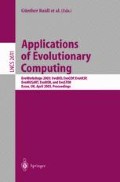Abstract
A study on a 220-piece corpus (baroque, classical, romantic, 12-tone, jazz, rock, DNA strings, and random music) reveals that aesthetically pleasing music may be describable under the Zipf-Mandelbrot law. Various Zipf-based metrics have been developed and evaluated. Some focus on music-theoretic attributes such as pitch, pitch and duration, melodic intervals, and harmonic intervals. Others focus on higher-order attributes and fractal aspects of musical balance. Zipf distributions across certain dimensions appear to be a necessary, but not sufficient condition for pleasant music. Statistical analyses suggest that combinations of Zipf-based metrics might be used to identify genre and/or composer. This is supported by a preliminary experiment with a neural network classifier. We describe an evolutionary music framework under development, which utilizes Zipf-based metrics as fitness functions.
Access this chapter
Tax calculation will be finalised at checkout
Purchases are for personal use only
Preview
Unable to display preview. Download preview PDF.
References
Adamic, L.A.: “Zipf, Power-laws, and Pareto — a Ranking Tutorial” (1999) http://ginger.hpl.hp.com/shl/papers/ranking/
Balaban, M., Ebcioğlu, K., and Laske, O., (eds.): Understanding Music with AI: Perspectives on Music Cognition. Cambridge: AAAI Press/MIT Press (1992)
Cope, D.: Virtual Music, MIT Press Cambridge (2001)
Howat, R.: Debussy in Proportion. Cambridge University Press (cited in [16]) Cambridge (1983)
Knott, R.: “Fibonacci Numbers and Nature”. http://www.mcs.surrey.ac.uk/Personal/R.Knott/Fibonacci/fibnat.html (2002)
Li, W.: “Zipf’s Law”. http://linkage.rockefeller.edu/wli/zipf/ (2002)
Machado, P., Cardoso, A.: “All the truth about NEvAr”. Applied Intelligence, Special issue on Creative Systems, Bentley, P., Corne, D. (eds), 16(2), (2002), 101–119
Manaris, B., Purewal, T., and McCormick, C.: “Progress Towards Recognizing and Classifying Beautiful Music with Computers”. 2002 IEEE SoutheastCon, Columbia, SC (2002) 52–57
Mandelbrot, B.B.: The Fractal Geometry of Nature. W.H. Freeman New York (1977)
Marillier, C.G.: “Computer Assisted Analysis of Tonal Structure in the Classical Symphony”. Haydn Yearbook 14 (1983) 187–199 (cited in [16])
May, M.: “Did Mozart Use the Golden Section?”. American Scientist 84(2). http://www.sigmaxi.org/amsci/issues/Sciobs96/Sciobs96-03MM.html (1996)
Meyer, L.B.: Emotion and Meaning in Music. University of Chicago Press Chicago (1956)
Meyer, L.B.: “Music and Emotion: Distinctions and Uncertainties”. In Music and Emotion — Theory and Research, Juslin, P.N., Sloboda, J.A. (eds), Oxford University Press Oxford (2001) 341–360
Miranda, E.R.: Composing Music with Computers. Focal Press Oxford (2001)
Nettheim, N.: “On the Spectral Analysis of Melody”. Interface: Journal of New Music Research 21 (1992) 135–148
Nettheim, N.: “A Bibliography of Statistical Applications in Musicology”. Musicology Australia 20 (1997) 94–106
Pareto, V.: Cours d’Economie Politique, Rouge (Lausanne et Paris) (1897) Cited in [9]
Salingaros, N..A., and West, B.J.: “A Universal Rule for the Distribution of Sizes”. Environment and Planning B(26) (1999) 909–923
Schroeder, M.: Fractals, Chaos, Power Laws. W.H. Freeman New York (1991)
Stuttgart Neural Network Simulator (SNNS), http://www-ra.informatik.uni-tuebingen.de/SNNS/).
Taylor, R.P., Micolich, A.P., and Jonas, D.: “Fractal Analysis Of Pollock’s Drip Paintings”. Nature, vol. 399, (1999), 422http://materialscience.uoregon.edu/taylor/art/Nature1.pdf
The Classical Music Archives. http://www.classicalarchives.com.
Voss, R.F., and Clarke, J.: “1/f Noise in Music and Speech”. Nature 258 (1975) 317–318
Voss, R.F., and Clarke, J.: “1/f Noise in Music: Music from 1/f Noise”. Journal of Acoustical Society of America 63(1) (1978) 258–263
Zipf, G.K.: Human Behavior and the Principle of Least Effort. Addison-Wesley New York (1972) (original publication Hafner Publishing Company, 1949)
Author information
Authors and Affiliations
Editor information
Editors and Affiliations
Rights and permissions
Copyright information
© 2003 Springer-Verlag Berlin Heidelberg
About this paper
Cite this paper
Manaris, B., Vaughan, D., Wagner, C., Romero, J., Davis, R.B. (2003). Evolutionary Music and the Zipf-Mandelbrot Law: Developing Fitness Functions for Pleasant Music. In: Cagnoni, S., et al. Applications of Evolutionary Computing. EvoWorkshops 2003. Lecture Notes in Computer Science, vol 2611. Springer, Berlin, Heidelberg. https://doi.org/10.1007/3-540-36605-9_48
Download citation
DOI: https://doi.org/10.1007/3-540-36605-9_48
Published:
Publisher Name: Springer, Berlin, Heidelberg
Print ISBN: 978-3-540-00976-4
Online ISBN: 978-3-540-36605-8
eBook Packages: Springer Book Archive

